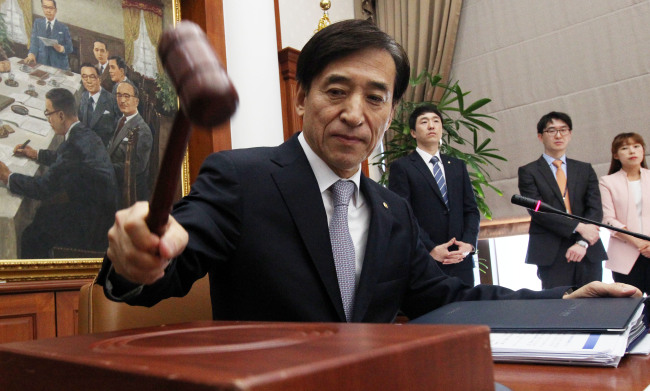Korea ponders options before Fed tightening
Consensus sees BOK hold rate steady in December, but 2016 is a guessing game
By 이선영Published : Dec. 7, 2015 - 18:00

With the U.S. Federal Reserve widely expected to make a major shift in its monetary policy next week, ending the world’s largest economy’s historic era of near-zero interest rates, many in Korea are trying to gauge its possible impact on the local economy and how to best cope with it.
Yet, the job inherently falls in the lap of the Bank of Korea.
The BOK is tasked with navigating the murky waters of monetary policymaking, expected to get even murkier if and when the Fed starts raising interest rates on Dec. 16, a move long expected and feared by emerging economies, including Korea.
The seven members of the BOK’s monetary policy board will meet Thursday, before the Fed decides, to review the current interest rate level. Korea’s key rate currently stands at a record low 1.5 percent, unchanged since June, and down 1 percentage point from the past year.
“There seems to be a market consensus that December will likely be a ‘no-move’ month,” said Seo Hyang-mi, an analyst from HI Investment & Securities, predicting the BOK will freeze the rate.
Prospects of the Fed tightening will be enough to have the BOK stand pat on its key rate at least to wait and see the actual impact of the U.S. rate change. Besides, the Korean economy’s better-than-expected performance in the third quarter has given the central bank some confidence to stick with its current stance, she added. Gross domestic product expanded 1.3 percent on-quarter in the July-September period, marking the fastest growth rate in over five years.
Look a little further ahead, however, things are not that easy to predict.
Higher interest rates in the U.S. are feared to prompt capital outflows from emerging markets and lead to a stronger dollar and weaker currencies in vulnerable economies. How hard this will affect the Korean economy, which, according to BOK Gov. Lee Ju-yeol, is gradually recovering on the back of a pickup in domestic consumption, is an open question.
Hinting at the BOK’s future approach to the U.S. move, the top central banker has said repeatedly that although the global economic environment is an important factor, Korea’s monetary policy is bound to be shaped by domestic matters.
“Even if the U.S. raises interest rates, the BOK doesn’t necessarily have to follow in the move right away, hiking its own rate,” he has said.
Chung Soon-won who sits on the BOK’s rate-setting board also said: “Even if the U.S. raises its key rate, it may take some time before we consider raising our own rate unless our country’s economy shows strong signs of recovery.”
“The most important element is local economic conditions.”
Many analysts differ in their forecasts.
While most see that Korea’s key rate will have to move in tandem with the U.S. borrowing rates, they differ in the details, including the timing and scope of a rate change.
And there are economists like Kwon Young-sun at the Hong Kong-based Nomura International, who predicts two rate cuts in Korea next year.
“The BOK is expected to lower the policy rate to 1 percent by the end of next year,” Kwon said.
“Adjusted for inflation, South Korea’s real interest rate is relatively higher than its partner countries, and too high to support the economy and exports.”
By Lee Sun-young
(milaya@heraldcorp.com)




![[Herald Interview] 'Amid aging population, Korea to invite more young professionals from overseas'](http://res.heraldm.com/phpwas/restmb_idxmake.php?idx=644&simg=/content/image/2024/04/24/20240424050844_0.jpg&u=20240424200058)











![[KH Explains] Korean shipbuilding stocks rally: Real growth or bubble?](http://res.heraldm.com/phpwas/restmb_idxmake.php?idx=652&simg=/content/image/2024/04/25/20240425050656_0.jpg&u=)

